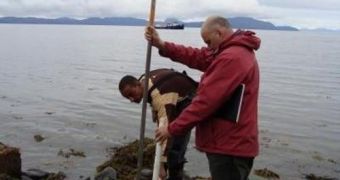The shores of the Prince William Sound island, in Alaska, were the most severely affected by the 1989 Exxon Valdez oil spill. Despite the extensive mitigation actions that were taken by authorities as soon as they could reach the reclusive scene of the accident, the oil leak spread considerably in the surrounding area, causing widespread devastation. Over the years, oil naturally degrades in the water, and experts were expecting to see large amounts of the petroleum remnants disappearing by now, However, this does not appear to be the case, and a new scientific study shows why.
Scientists at the Temple University have recently conducted an investigation into the way oil is biodegrading on the beaches of Prince William Sound. The massive spill is known to have affected at least 1,300 miles of shoreline, having spilled more than 11 million gallons of crude into the Alaskan waters. Now, the research team has determined that the shorelines and beaches have extremely low amounts of nutrients left, and also that the concentration of oxygen there is worryingly low. As a direct result of this, the speed of oil degradation is decreasing, rather than maintaining constant. This implies that it will take a lot longer for the residues to disappear than experts first calculated.
“You have a high amount of oxygen in the seawater, so you would like to think that the oxygen would diffuse in the beach and get down 2-4 inches into the lower layer and get to the oil. But the outward movement of the water in the lower level is blocking the oxygen from spreading down into that lower layer,” the Director of the TU College of Engineering (CE) Center for Natural Resources Development and Protection, Michael Boufadel, explains. He has also been the leader of the new research effort, which has been partially funded under a grant from the Exxon Valdez Oil Spill Trustee Council. The team reveals that it is currently working on methods of delivering nutrients and oxygen into the most affected areas, so that the anaerobic degradation of oil is boosted.
The new work unfortunately confirms the results of a 1994 study of the same area, which also revealed at the time that oxygen and nutrient concentrations were reaching very low levels. Boufadel, who is also the chair of the Temple University Department of Civil and Environmental Engineering, adds that the oxygen levels in Prince William Sound are at least ten times lower than those required for an optimal anaerobic degradation speed. Details of the work appear in the January 17 online issue of the respected scientific journal Nature Geoscience, ScienceDaily reports.

 14 DAY TRIAL //
14 DAY TRIAL //